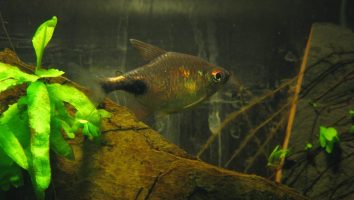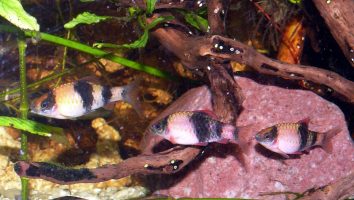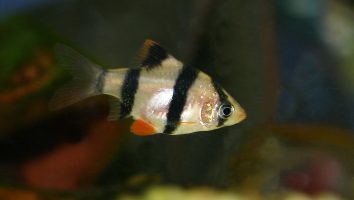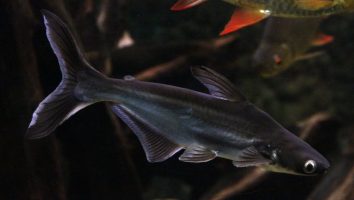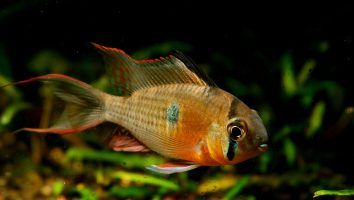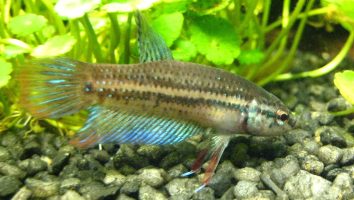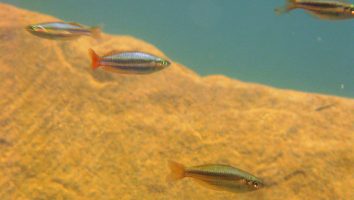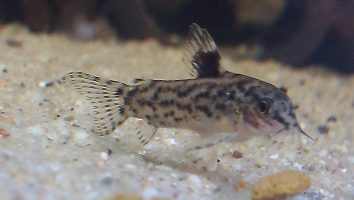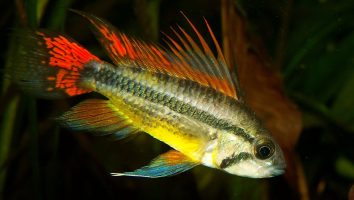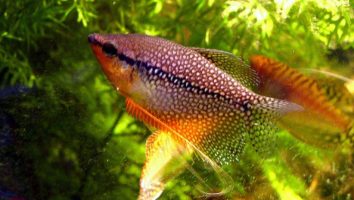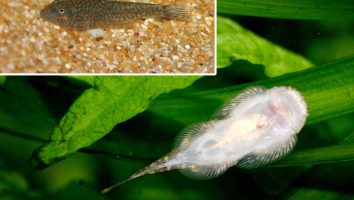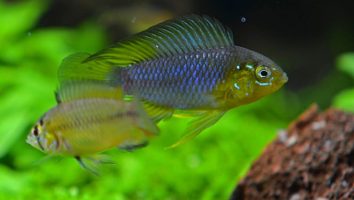The American Flagfish is a beautiful, unique, and hardy freshwater fish that is perfect for the beginner aquarium.
This species is native to the southeastern United States, and can be found in a variety of habitats including ponds, streams, and lakes.
One of the things we love about this fish is that it is very adaptable and can thrive in a wide range of water conditions.
This makes the American Flagfish a perfect choice for the first time fishkeeper.
In this guide, we will teach you everything you need to know about American Flagfish care. Tank size, diet, lifespan, tank mates, and more!
Table of contents
Species overview
The American Flagfish (Jordanella floridae) is a type of killifish that’s found in Florida, Georgia, and South Carolina in the United States.
They prefer slow-moving waters with a lot of vegetation. This could be anything from ponds and lakes to swamps and marshes.
In the wild, their diet consists of mostly insects and their larvae. However, they are known to eat plant matter on occasion as well.
The American Flagfish is a very peaceful fish that’s perfect for community tanks. They’re also very easy to care for, which makes them a great choice for beginner aquarists.
Appearance
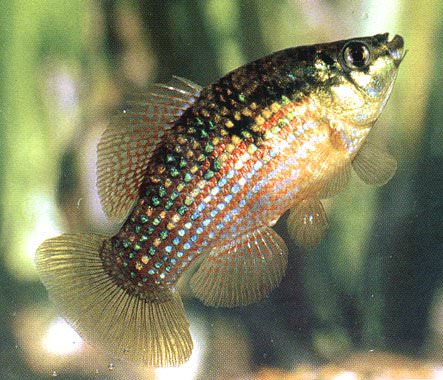
The American Flagfish is a very colorful freshwater fish that is sure to stand out in any aquarium.
The body of this fish is very thin and elongated. It’s almost entirely covered in scales except for a few bare patches around the head and fins.
The coloration of this fish is where things get really interesting. The base color of the American Flagfish is a bluish-silver. However, there are a number of other colors that cover their body in a beautiful pattern.
The fins on this fish are also very colorful. The dorsal fin has a dark base with a bright red spot in the center. The anal fin is mostly yellow with a dark base. The caudal fin is forked and has a yellow and red coloration.
The American Flagfish is a very pretty fish that is sure to stand out in any aquarium.
Lifespan
The typical lifespan of an American flagfish is 3 to 5 years. As with most fish, there are a number of factors that impact their life expectancy.
One of the biggest is the quality of the water they live in. These fish are very sensitive to water quality and even a slight change can shorten their lifespan.
Another factor is their diet. American flagfish are omnivores and need a diet that includes both plant and animal matter. If they don’t get the right balance of nutrients, it can shorten their lifespan.
Size
The maximum size for an American Flagfish is around 3 inches, with the average being closer to 2 inches. However, these fish are often much smaller in captivity due to poor diet and water conditions.
Tank
Tank Size
The recommended minimum tank size for American Flagfish is 20 gallons. If you’re looking for a smaller freshwater fish that can still provide some color and excitement in your tank, this might be the fish for you.
As with any fish, it’s always best to give them as much space as possible. If you can accommodate a larger tank, we recommend it. These fish are active and will often swim in schools so the more space you can give them the better.
Water Parameters
The American flagfish is a beautiful and unique freshwater fish. They’re also a very hardy species that can adapt to a wide range of water conditions.
While they can live in a wide variety of water types, they do best in slightly acidic to neutral water that’s on the softer side.
Here are some suggested water parameters for the American flagfish:
- Water temperature: 70 to 80 degrees Fahrenheit
- pH levels: 6.0 to 8.0
- Water hardness: 2 to 12 dGH
- Alkalinity Levels: 4-8 dKH
What To Put In Their Tank
American Flagfish are one of the few species of fish that we recommend a completely bare tank for.
The primary reason for this is because these fish are known for their tendency to uproot plants. They’re also pretty good at stirring up the substrate which can make a mess of things.
Aquatic plants can still be included if you really want to, but we recommend either going with something that’s very hard to uproot or something that can be easily replaced.
Another thing to keep in mind is that these fish like to jump. A lot. It’s not uncommon for them to completely clear the surface of the water if they get startled.
For this reason, we recommend keeping a tight fitting lid on their tank at all times. If you have an aquarium with an open top, then make sure the edges are high enough that they can’t jump out.
As for decorations, a few rocks or driftwood pieces can add some visual interest to their habitat. Just make sure that anything you put in is too heavy for them to move around.
Common Diseases
The American Flagfish is a hardy fish that doesn’t usually get sick. However, there are a few potential diseases that you should be aware of.
The most common one is ich. This is a parasitic infection that is very common in freshwater fish. It’s caused by a protozoan thatAttach themselves to the skin of the fish and cause white spots to form.
If left untreated, ich can be fatal. However, it is fairly easy to treat. The most common method is to raise the temperature of the water to speed up the life cycle of the parasite. This will cause them to detach from the fish and die.
Other potential diseases include bacterial infections, fungal infections, and parasites. These are all fairly rare in American Flagfish, but they can still happen.
As with any other fish, the best way to prevent these diseases is to maintain a clean and stable environment. A well-kept tank with high-quality water is the best defense against disease.
Behavior & Temperament
The American Flagfish is a unique creature that is both beautiful and fun to watch. This fish is relatively peaceful, but it can be a bit nippy. It’s not recommended to keep this fish with smaller tank mates because it may mistake them for food.
Otherwise, the American Flagfish is a hardy creature that is easy to care for. It’s a good beginner fish because it’s not too demanding and it’s tolerant of a wide range of water conditions.
This fish gets its name from its beautiful coloration. The body is a deep blue with orange and yellow stripes running down the length of it. The fins are also orange and yellow, and the tail is forked.
The American Flagfish is a relatively active fish. It will often swim near the surface of the water in search of food.
Tank Mates
American Flagfish are a schooling species, so they need to be kept in groups of at least six. This is important for their social structure and overall health.
In terms of compatibility, American Flagfish get along with most species. They’re not overly aggressive and will usually leave other fish alone.
Of course, there are always exceptions to the rule. So, it’s always a good idea to research any potential tank mates before adding them to the same aquarium.
With that said, here are some compatible species that make good American Flagfish tank mates:
- Guppies
- Endler’s Livebearers
- Neon Tetras
- Cardinal Tetras
- Ghost Shrimp
- Cherry Shrimp
- Amano Shrimp
- Mystery Snails
Breeding
The American flagfish is a beautiful fish that’s easy to breed in captivity. They’re not too picky when it comes to their habitat, and they will readily breed in the average home aquarium.
The first step is to identify the males and females. males tend to be a bit larger and more colorful than the females. They also have longer fins.
Once you’ve got your pair, it’s time to set up the breeding tank. The tank should be at least 20 gallons and have a fine gravel substrate.
Add some plants and hiding places for the fish. Then, fill the tank with water that’s around 77 degrees Fahrenheit.
When everything is ready, add the pair of fish to the tank. They will likely start breeding within a week or so.
The female will lay her eggs on a plant leaf or the glass of the tank. After she lays the eggs, the male will fertilize them.
Once the eggs are fertilized, the male will guard them until they hatch. This usually takes about a week.
Once the fry have hatched, you can remove the adults from the tank. The fry will feed on microscopic organisms in the water. You can supplement their diet with baby brine shrimp.
Conclusion
The American Flagfish is a great fish for anyone who wants a little bit of color and personality in their tank.
They’re also very easy to care for, which is always a bonus.
We do want to reiterate that these fish can be aggressive, so be sure to keep that in mind when adding them to your tank.
Other than that, we think they’re a great choice for most people and we hope you’ll enjoy them as much as we do!

